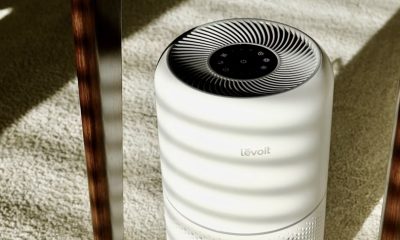NewsMakers
When people express love, they feel more loved

Expressing love may lead to increased feelings of being loved, which can have downstream effects on people’s senses of fulfillment and wellbeing.
Zita Oravecz and colleagues from Pennsylvania State University, U.S., present these findings in the open-access journal PLOS One from a survey tracking feelings and acts of love over time.
Love is usually not grand gestures. More often, people experience love as smaller and more regular acts. This is the basis of a psychological theory called “positivity resonance,” which considers how the small, everyday acts of love create and strengthen connections.
These acts can generally be divided into two categories: giving love and receiving love, and the researchers aimed to study how these types of love influence each other over time.
Over a period of four weeks, 52 participants received prompts sent six times a day asking about their experiences of love in that moment. The participants responded on a scale of 0 to 100 for each question about how much they felt loved and how much they expressed love since the last survey. The researchers analyzed the variations in these responses over time.
The researchers found that when people express love to others, they then tend to feel more loved themselves. However, people who received love were not more likely to then express love.
The researchers noted that feelings of being loved tended to persist longer than feelings of expressing love. These sorts of differences may influence how people benefit from the experience of love, such as with improved psychological wellbeing and health.
The researchers also surveyed the participants’ general happiness and asked them about whether they considered themselves to be flourishing in their lives. Participants who felt loved were more likely to rate themselves as flourishing.
The findings point to potential psychological interventions, encouraging people to express love so that they feel more loved.
The authors add: “Let’s spread more love in the world by expressing love throughout our daily lives.”
NewsMakers
Forget materialism, a simple life is happier: research
The commitment to simple living, or ‘voluntary simplicity’ as it is formally known, leads to wellbeing through providing more opportunities for personal interaction and social connection than conventional contexts of exchange, such as community gardens, sharing resources, and peer-to-peer lending platforms.

In an age where billionaires and conspicuous consumption are increasingly on display, new Otago-led research shows a simple life really is a happier life.
The study led by University of Otago – Ōtākou Whakaihu Waka Department of Marketing researchers has recently been published in the Journal of Macromarketing.
After setting out to understand the relationship between consumption and wellbeing, the researchers found people are happier and more satisfied when adopting sustainable lifestyles and resisting the temptations of consumerism.
They analysed data from a representative sample of more than 1000 New Zealanders, made up of 51 per cent men and 49 per cent women, with a median age of 45 and a median annual household income of $50,000.
They found the commitment to simple living, or ‘voluntary simplicity’ as it is formally known, leads to wellbeing through providing more opportunities for personal interaction and social connection than conventional contexts of exchange, such as community gardens, sharing resources, and peer-to-peer lending platforms.
Women are more likely to adopt a simple life than men, although more research is needed to understand why.
Co-author Associate Professor Leah Watkins says consumer culture promotes happiness as being typically associated with high levels of income and the capability it affords to acquire and accumulate material possessions.
“However, research is clear that attitudes to, and experiences of, materialistic approaches to life do not lead to increases in happiness or wellbeing. Nor do they lead to sustainable consumption necessary for planetary health.”
Between 2000 and 2019, global domestic material consumption increased by 66 per cent, tripling since the 1970s to reach 95.1 billion metric tons.
Growing consumer affluence and higher living standards have resulted in warnings of alarming trends of environmental degradation from human consumption.
This, coupled with global warming and post-pandemic health and financial anxieties, has led researchers and policymakers to call for a better understanding of the links between simple consumer lifestyles and wellbeing.
But co-author Professor Rob Aitken says this isn’t a case of just throwing out all your worldly possessions.
“It’s not directly the commitment to material simplicity that leads to wellbeing, but the psychological and emotional need fulfilment that derives from relationships, social connection, community involvement and a sense of living a purposeful and meaningful life.
“In a world where billionaire weddings are treated like state occasions and private yachts are the new status symbols, voluntary simplicity offers a quiet, powerful counter-narrative — one that values enough over excess, connection over consumption, and meaning over materialism.”
NewsMakers
Plant-based nutrient improves immune cells’ ability to fight cancer
A plant-derived carotenoid best known for protecting vision, may also act as an immune-boosting compound by strengthening the cancer-fighting activity of immune cells.

In a new study, researchers from the University of Chicago discovered that zeaxanthin, a plant-derived carotenoid best known for protecting vision, may also act as an immune-boosting compound by strengthening the cancer-fighting activity of immune cells. The findings, which were published in Cell Reports Medicine, highlight the potential of zeaxanthin as a widely available supplement to improve the effectiveness of cancer immunotherapies.
“We were surprised to find that zeaxanthin, already known for its role in eye health, has a completely new function in boosting anti-tumor immunity,” said Jing Chen, PhD, Janet Davison Rowley Distinguished Service Professor of Medicine and senior author of the study. “Our study show that a simple dietary nutrient could complement and strengthen advanced cancer treatments like immunotherapy.”
How does this nutrient work?
The study builds on years of work by Chen’s lab to better understand how nutrients influence the immune system. By screening a large blood nutrient library, the team identified zeaxanthin as a compound that directly enhances the activity of CD8+ T cells, a crucial type of immune cell that kills tumor cells. These cells rely on a molecular structure called the T-cell receptor (TCR) to recognize and destroy abnormal cells.
The researchers found that zeaxanthin stabilizes and strengthens the formation of TCR complex on CD8+ T cells upon interacting with the cancer cells. This, in turn, triggers more robust intracellular signaling that boosts T-cell activation, cytokine production, and tumor-killing capacity.
Zeaxanthin improves immunotherapy effects
In mouse models, dietary supplementation with zeaxanthin slowed tumor growth. Importantly, when combined with immune checkpoint inhibitors – a type of immunotherapy that has transformed cancer treatment in recent years – zeaxanthin significantly enhanced anti-tumor effects compared to immunotherapy alone.
To extend the findings, the researchers tested human T cells engineered to recognize specific tumor antigens and found that zeaxanthin treatment improved these cells’ ability to kill melanoma, multiple myeloma, and glioblastoma cells in laboratory experiments.
“Our data show that zeaxanthin improves both natural and engineered T-cell responses, which suggests high translational potential for patients undergoing immunotherapies,” Chen said.
A safe and accessible candidate
Zeaxanthin is sold as an over-the-counter supplement for eye health, and is naturally found in vegetables like orange peppers, spinach, and kale. It’s inexpensive, widely available, well-tolerated and, most importantly, its safety profile is known – which means it can be safely tested as an adjunct to cancer therapies.
The study also reinforces the importance of a balanced diet. In their previous research, Chen’s group discovered that trans-vaccenic acid (TVA), a fatty acid derived from dairy and meat, also boosts T-cell activity – but through a different mechanism. Together, the findings suggest that nutrients from both plant and animal sources may provide complementary benefits to immune health.
Clinical applications of zeaxanthin
Although the results are promising, the researchers emphasize that the work is still at an early stage. Most of the findings come from laboratory experiments and animal studies. Thus, clinical trials will be needed to determine whether zeaxanthin supplements can improve outcomes for cancer patients.
“Our findings open a new field of nutritional immunology that looks at how specific dietary components interact with the immune system at the molecular level,” Chen said. “With more research, we may discover natural compounds that make today’s cancer therapies more effective and accessible.”
The study, “Zeaxanthin augments CD8+ effector T cell function and immunotherapy efficacy,” was supported by grants from the National Institutes of Health, the Ludwig Center at the University of Chicago, and the Harborview Foundation Gift Fund.
Additional authors include Freya Zhang, Jiacheng Li, Rukang Zhang, Jiayi Tu, Zhicheng Xie, Takemasa Tsuji, Hardik Shah, Matthew Ross, Ruitu Lyu, Junko Matsuzaki, Anna Tabor, Kelly Xue, Chunzhao Yin, Hamed R. Youshanlouei, Syed Shah, Michael W. Drazer, Yu-Ying He, Marc Bissonnette, Jun Huang, Chuan He, Kunle Odunsi, and Hao Fan from the University of Chicago; Fatima Choudhry from DePaul University, Chicago; Yuancheng Li and Hui Mao from Emory University School of Medicine, Atlanta; Lei Dong from University of Texas Southwestern Medical Center, Dallas; and Rui Su from Beckman Research Institute, City of Hope, Duarte, CA.
NewsMakers
Understanding hypertrophic cardiomyopathy
Hypertrophic cardiomyopathy, also called HCM, is the leading cause of sudden cardiac death in young athletes, sometimes with no warning signs.

Hypertrophic cardiomyopathy, also called HCM, is the leading cause of sudden cardiac death in young athletes, sometimes with no warning signs. It is characterized by the thickening and stiffening of the heart walls, which can impede the heart’s ability to pump blood efficiently since the chambers cannot fill up.
In addition, HCM is the most common inherited heart disease, affecting 1 in 500 people in the US alone, according to the American Heart Association. Because HCM runs in families, first-degree relatives – including parents, siblings and children – should be screened if a family member has been diagnosed.
Consider this information to get a better understanding of this life-altering genetic condition’s symptoms and diagnosis, which can make a crucial difference in managing the disease effectively.
Recognizing the Signs and Symptoms
The symptoms and severity of HCM can vary widely among individuals. While some people may experience no symptoms at all, common symptoms include fatigue, fainting, shortness of breath, dizziness, chest pain and irregular heartbeats, especially during physical activity. Research shows Black male athletes in high-intensity sports like football and basketball may be at higher risk.
The Importance of Family History in Diagnosis
Because HCM is a genetic condition, family history is a critical component in its diagnosis. If someone in your family has been diagnosed with HCM, heart failure or cardiac arrest, children, siblings and parents should be screened for HCM. Genetic testing and echocardiograms are commonly used to catch HCM early. These tests assess the thickness of the heart muscle and observe blood flow, which can indicate the presence of the disease.
There are two main types of HCM – obstructive and nonobstructive – and treatment options vary depending on the type and severity of symptoms.
If HCM runs in your family, don’t wait. Talk to your doctor about screening options and encourage your loved ones to do the same. Early detection can be lifesaving. To learn more about HCM, visit heart.org/HCMStudentAthlete.
-

 Product Showcase3 weeks ago
Product Showcase3 weeks agoJetstar announces direct flights to Australia from Manila and Cebu
-

 Product Showcase4 weeks ago
Product Showcase4 weeks agoManulife Philippines partners with Watsons for Better Days Health Initiative
-

 Product Showcase2 weeks ago
Product Showcase2 weeks agoPalawan Group of Companies Introduces ProtekTODO
-

 Wellness4 weeks ago
Wellness4 weeks agoWalking further and faster linked to reduced risk of heart attacks, heart failure, stroke in people with high blood pressure
-

 NewsMakers4 weeks ago
NewsMakers4 weeks agoAir purifiers may reduce heart risks for people exposed to traffic pollution
-

 Product Showcase4 weeks ago
Product Showcase4 weeks agoJollibee Group Foundation and partners inaugurate first BLT Central Kitchen in BARMM
-

 Destinations4 weeks ago
Destinations4 weeks agoRevisiting the no-entry-allowed Malabrigo Point Lighthouse
-

 Nutrition3 weeks ago
Nutrition3 weeks agoFall for flavor: The new Maple Cloud Cream Collection is here to sweeten, only at Seattle’s Best Coffee

















